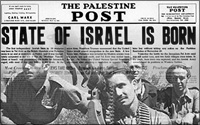The Mishnah
 Rabbi Judah the Prince was not only wealthy and head of the Sanhedrin. His greatest accomplishment transcended the time in which he lived. That was Mishnah.
Rabbi Judah the Prince was not only wealthy and head of the Sanhedrin. His greatest accomplishment transcended the time in which he lived. That was Mishnah.
The Mishnah is the first written record of what was the Oral Law. As the name implies, the Oral Law was never written down as a formalized text or permanent record. It had been passed on from one scholar to the next, from one generation to the next.
In each generation there were experts in different areas of the Oral Law. One scholar was an expert in the laws of the Sabbath, for example, whereas another man was an expert in torts and damages. All together, they were the ones who transmitted the full body of the traditions of Moses down through the centuries to the Jewish people.
After the defeat of Bar Kochba, when it became abundantly clear that the Jewish people would be in for a long exile, the system of learning based upon oral transmission began to change of necessity.
Individuals in earlier generations had kept notes that summarized the Oral Law, but these notes were kept private. Rabbi Meir, whom we discussed previously, was one of those who possessed such a body of notes. However, these notes were not necessarily fully organized and did not always reflect the varying opinions in Jewish law.
The Mishnah would finally be published in an organized, authoritative form a generation after Rabbi Meir by the great Rabbi Judah the Prince. Rabbi Judah did not start from scratch, however. He was the redactor or editor of the Mishnah, not its creator.
Rabbi Judah the Prince
Rabbi Judah the Prince was son of Rabbi Shimon ben Gamaliel II. In his time, the center of Jewish activity moved north to the Galilee. Previously, it had moved from Jerusalem to Yavne and then from Yavne to the lower Galilee and then the upper Galilee to the town of Beit She’arim.
Rabbi Judah the Prince was literally the man who had everything. He was a descendant of King David and Hillel. He was aristocratic and handsome. He was known as a pious and holy man.
He had as dear friend the man who later became the emperor of Rome, Antoninus. There is a dispute among scholars whether this was speaking about Antoninus Pius, who was the successor to Hadrian, or Antoninus Marcus Aurelius, who was the successor to Antoninus Pius – and who was one of the most famous of the Roman emperors and one of the leading philosophers of the ancient world. Either way, Rabbi Judah the Prince was in close communication with and an advisor to the emperor.
The Talmud says that Rabbi Judah the Prince was wealthy beyond description. Yet, he was able to lift his ten fingers before his death and say, “I never benefitted from this world.” What he meant was that although he was fabulously wealthy he never used a penny of it for personal aggrandizement or pleasure. Indeed, the Talmud records how he suffered enormously in his life, including what was apparently a very painful urinary tract disease.
Rabbi Judah the Prince was not only wealthy and learned; he was the head of the Sanhedrin. Yet, his greatest accomplishment transcended the time in which he lived. That was Mishnah.
If It’s the “Oral” Law, Why is it Written?
In his time, Jewish tradition was faced with an enormous problem. Jewish law demanded that the Oral Law remain oral. It was forbidden to write down. How, then, did Rabbi Judah the Prince write it?
Citing the verse, “It is the time to do something on behalf of God because Your Torah has been desecrated” (Psalms 119:126), he reasoned that when the Jewish people are threatened with extinction, and therefore the Torah itself is in danger of being forgotten, one can go against the Torah, so to speak, to save it.
If one thinks about it, of course, one will see what a dangerous concept that was. If one takes that concept to its illogical conclusion one can do anything. Indeed, that has happened many times in Jewish history. People have misapplied this principle and used it to change the Torah.
The greatness of Rabbi Judah the Prince and his generation is that they violated the rule in order to save the Torah — and they were right. Their decision has withstood the test of time. By contrast, all the other later attempts have not withstood the test of time.
The Tip of the Iceberg
The Mishnah was written in classic Hebrew. In fact, today we call it “Mishnaic Hebrew.” It is written extremely concisely, like notes or highlights of a much larger body of information; it is the proverbial the tip of the iceberg. In many places it is written almost cryptically, as if the meaning was intentionally hidden. The purpose of all this was to make the Mishnah a vehicle upon which the Oral Law would be expounded by a teacher to a student. In other words, the cryptic nature perforce demanded a teacher who possessed and was master of the larger body and a student who would learn from him. This student would in time become a teacher himself and then pass it on to a student and so on.
Rabbi Judah the Prince did not develop the Mishnah on his own. He had a tremendous academy and in it were great men in their own right. One of them was Rabbi Chiya (Chiya is the Aramaic name for Chaim, “Life”). He was author of what is called Braisos, which in short were notes that did not make it into the Mishnah for one reason or another. (The Aramaic word braisos literally means “outside,” because these notes were “outside” the official Mishnaic text.) They cover the exact same subject as the Mishnah — some Braisos are even word-for-for the Mishnah –nevertheless, most expound upon the Mishnah.
Rabbi Chiya, who was the colleague and disciple of Rabbi Judah the Prince, published the Braisos after the Mishnah. Together, the Mishnah and the Braisos form the basis for the Talmud. Very often the Talmud analyzes a topic by comparing a Mishnah and a Braisah. Why was this nuance added? In short, the Talmud uses the Braisos to develop the Mishnah.
It would be another three centuries before the Talmud would come to be written – and for much the same reasons that the Mishnah was: persecution. Nevertheless, the basis for the analytic discussions that came to characterize the Talmud were already in existence in Rabbi Judah the Prince’s time.
Seeds of Dispersion
The publication of the Mishnah occurred approximately 190 to 200 CE. During the time of Rabbi Judah the Prince the Jewish community in the Land of Israel already began to dwindle. There were a number of reasons for this. The first was economic. Without the Temple there was very little “tourism,” so to speak.
Furthermore, the country had been devastated by centuries of war. It had become a backwater land. Instead of playing the prominent role it once played in world and Roman politics it now played a second or tertiary role.
Jews began to move. Approximately three out of four who moved went to Babylon where there had long been a Jewish infrastructure, including academies, synagogues and communities. Babylon also had the advantage of being fairly free of Roman domination and Christian influence.
Among the other places that Jews moved to was Spain. Originally, they came to North Africa, where they conducted business, and then they crossed into Spain, which by then was a Roman colony. Undoubtedly, Jews must have come to France and Germany as well. They did not necessarily settle there, but followed in the heels of the Roman legions as traders and merchants.
Even as Jews began to inhabit all areas of the Roman Empire there remained a strong community in the Land of Israel, but it was a community in decline. Indeed, from the death of Judah the Prince it would continue to decline steadily. Finally, a century and a half later it would almost be completely gone. When Rome will fall and the Dark Ages ushered in the Jews will be primarily in two places: Egypt and Babylon. The community in the Land of Israel will be very small.
Therefore, this was a turning point in Jewish history. That makes it all more the necessary to understand the importance of the Mishnah. It was how Jewish laws, ideas and customs were preserved.
Rabbi Judah the Prince was almost prophetic in his foresight how the future would unfold. He knew that the system of transmitting the law orally without a strong centralized body in the Land of Israel would no longer prove successful. It had to become a written document.
A Living Document
The problem with a written document, of course, is that it becomes frozen. The genius of the Talmud — and the later development after the Talmud — is that it never was frozen. It was and remains a living Oral Law. Every age and every society breathes life into it all over again.
The credit for that goes to Rabbi Judah the Prince who put together the Mishnah in such a way that it would be a vehicle for a living document not a mausoleum to a past that was no longer alive.
There are perhaps 20 to 30 people in history who are the teachers of the Jewish people. They are the key players in the chain of Jewish tradition. Rabbi Judah the Prince, by all accounts, is one of them. Through his own great efforts he was able to communicate the entire Torah to all of the Jewish people for all ages in a manner that maintains its life and creativity.











